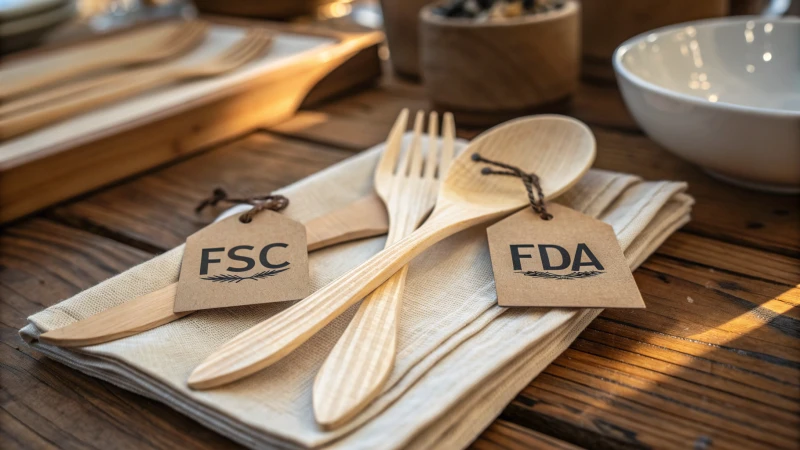
Ever wondered if the wooden cutlery you use is truly up to hygiene standards?
Ensuring disposable wooden cutlery meets hygiene standards involves rigorous quality control and obtaining certifications like ISO 22000. This guarantees product safety and builds consumer trust, making hygiene a top priority in sustainable products.
Remember the first time you switched to wooden cutlery at your favorite café? It felt great knowing you were doing a small part for the environment. But, like me, you probably wondered about the hygiene aspect. That's why understanding the ins and outs of these standards is crucial. Let's explore how these standards are crafted and why they're so essential for maintaining both consumer trust and your business's reputation.
ISO 22000 certification is required for wooden cutlery.False
ISO 22000 is not mandatory but recommended for food safety.
Hygiene standards enhance consumer trust in wooden cutlery.True
Meeting hygiene standards assures consumers of product safety.
What Certifications Should You Look For in Wooden Cutlery?
Choosing the right wooden cutlery is more than just a purchase; it's about aligning with values like quality and sustainability. Here's how certifications can guide you.
Look for certifications like FSC for responsible sourcing, FDA for food safety in the U.S., and LFGB for compliance with European standards. These ensure the cutlery is eco-friendly and safe for use.

Understanding Certification Importance
When I first started exploring eco-friendly options, understanding the certifications was like learning a new language. But, as it turns out, these labels are the unsung heroes that ensure our wooden cutlery meets sustainability1, quality, and safety standards. Think of them as a seal of approval that reassures both our conscience and consumer responsibility.
FSC Certification: A Mark of Sustainability
I remember the first time I saw the FSC logo; it was on a beautifully crafted set of cutlery that seemed to tell a story of forests responsibly managed. The Forest Stewardship Council (FSC) certification means that the wood comes from forests that are cared for with the future in mind, supporting both environmental conservation and communities reliant on forestry.
| Certification | Significance |
|---|---|
| FSC | Sustainable forest management practices |
FDA Certification: Ensuring Food Safety
Living in the USA, I've grown to appreciate the importance of FDA certification. This label ensures that the wooden cutlery I use is safe for my family and friends. It’s like having an invisible shield against harmful chemicals, giving peace of mind that every meal is both delightful and safe.
LFGB Certification: Meeting European Standards
For those of us who enjoy European goods, the LFGB certification is vital. This German standard is one of the strictest, ensuring products are thoroughly tested for safety. It's comforting to know that when I choose LFGB-certified items, I'm opting for some of the safest options available.
Additional Certifications to Consider
Depending on your needs, additional certifications like PEFC, ISO 22000, and BPI might be relevant. Each offers a different angle on sustainability or safety:
- PEFC (Programme for the Endorsement of Forest Certification): This echoes FSC's ethos by promoting sustainable forest management.
- ISO 22000: Ensures rigorous food safety management across supply chains.
- BPI (Biodegradable Products Institute): Validates claims about biodegradability, which is crucial if you're passionate about reducing waste.
Understanding these certifications has empowered me to make informed choices, ensuring that my selections not only meet my personal values but also support broader sustainability and safety goals.
FSC certification ensures sustainable forest management.True
FSC certifies wood from responsibly managed forests, promoting sustainability.
FDA certification is mandatory for all wooden cutlery globally.False
FDA certification is required only for products sold in the USA.
How Do Manufacturing Processes Affect Hygiene Standards?
Ever wondered how your everyday products stay safe and hygienic?
Manufacturing processes influence hygiene standards by controlling contamination, selecting appropriate materials, and following safety protocols. By implementing best practices, we ensure product safety and meet regulatory requirements.

The Role of Manufacturing Processes in Hygiene Control
I've always been fascinated by how things are made, especially in industries where cleanliness is non-negotiable. When I first stepped into a manufacturing plant, I was amazed at the sheer attention to detail required to maintain hygiene. It's not just about using the right materials but understanding their properties deeply. I remember walking through a food production2 facility and noticing how every decision—from material choice to machinery maintenance—was driven by the need to prevent contamination. For instance, selecting materials that resist bacterial growth isn't just a smart choice; it's essential.
Contamination Control Measures
Effective contamination control feels like an art form combined with science. It’s about more than just cleaning—it’s about creating an environment where hygiene is part of the culture. I recall a conversation with a quality manager who told me, "Regular equipment cleaning and worker training are our first lines of defense." They had adopted ISO standards3, which reassured me that they were serious about minimizing risks.
| Contamination Control Measures | Description |
|---|---|
| Use of Sanitizers | Chemical agents that reduce microbial load |
| Regular Equipment Cleaning | Routine procedures to maintain cleanliness |
| Worker Hygiene Training | Educating staff on hygiene practices |
Impact of Technology on Hygiene Standards
Technology is another game-changer. Automation has taken hygiene to new heights by reducing the human factor where contamination might occur. Watching robots handle delicate tasks in healthcare facilities, I realized how critical such advancements are for maintaining sterility. Less human contact translates to fewer opportunities for contamination, a big win in sectors reliant on compliance with strict health regulations4.
Material Selection and Quality Control
The materials we choose can make or break our hygiene efforts. I've seen firsthand how selecting non-porous materials can prevent the buildup of bacteria in unexpected places. But it’s not just about choosing the right materials; it's about maintaining rigorous quality control—testing and validating to ensure everything meets industry standards. Embracing eco-friendly materials5 also supports sustainability while aligning with hygiene needs.
Implementing these stringent quality controls means we catch potential issues before they spiral out of control, keeping consumer safety at the forefront.
Regulatory Compliance and Certifications
Navigating regulatory waters is never optional—it's mandatory for anyone serious about hygiene in manufacturing. When I think about certifications like ISO 220006, it’s clear they provide more than a guideline; they set a benchmark for ensuring our products are created under the most stringent conditions possible.
| Certification | Purpose |
|---|---|
| ISO 22000 | Food Safety Management Systems |
| GMP | Good Manufacturing Practices |
| HACCP | Hazard Analysis Critical Control Point |
These certifications not only boost our credibility but also assure customers and regulatory bodies that we mean business when it comes to hygiene. Staying updated with these regulations is not just about compliance; it's about achieving excellence and peace of mind.
ISO standards minimize contamination risks.True
ISO standards provide a structured approach to reducing contamination.
Automation increases human contact with products.False
Automation reduces human contact, lowering contamination risk.
Why Is Hygiene Compliance Crucial for Market Success?
Ever wondered how clean practices could be your secret weapon in business success?
Hygiene compliance is essential for ensuring product safety and maintaining consumer trust, which directly contributes to market credibility. By following strict hygiene standards, businesses can prevent contamination, bolster brand reputation, and meet regulatory requirements, ensuring long-term success.

The Role of Hygiene in Product Safety
I'll never forget the day when a colleague in the food service industry recounted how a minor slip in hygiene protocols led to a significant setback. In places like restaurants or healthcare facilities, the stakes are incredibly high. Hygiene compliance isn't just about keeping things tidy; it's about ensuring that every product that reaches a customer is safe and trustworthy. I remember thinking, "That could have been avoided," as I listened to their story of dealing with contamination risks and the resulting liabilities.
| Industry | Key Hygiene Standards |
|---|---|
| Food Service | HACCP, FDA Regulations |
| Healthcare | ISO 13485, WHO Guidelines |
| Manufacturing | GMP, OSHA Standards |
Following these standards isn't just a checkmark—it's a commitment to consistency in quality that keeps your customers coming back.
Impact on Brand Reputation and Consumer Trust
In today's world, customers are more informed and vigilant than ever. A friend once shared how a single hygiene lapse at their favorite restaurant went viral on social media, leading to a temporary closure. That story stuck with me because it highlighted how crucial hygiene is in maintaining consumer trust. Companies like WonBon7, known for their stringent hygiene protocols, show us that prioritizing cleanliness isn't just good practice—it's a competitive advantage.
- Trust Factor: When customers see consistent hygiene efforts, they feel more assured about what they're consuming.
- Brand Image: A brand synonymous with excellent hygiene becomes synonymous with reliability and care.
Regulatory Compliance and Market Access
Navigating the maze of regulations like those from the FDA or EU can feel daunting. A mentor once advised me to view these not as obstacles but as opportunities to enhance our market reach. By aligning with these standards, businesses like ours at WonBon open doors to new international markets. I often remind myself that this global approach isn't just a strategy—it's a passport to sustainable growth.
Operational Efficiency and Cost Management
One of the best pieces of advice I've received is that good hygiene practices aren't just about avoiding penalties—they're about efficiency. I remember implementing standardized cleaning processes at a previous job and being amazed at how much downtime we reduced from contamination incidents. It was a lesson in how cleanliness and efficiency go hand in hand.
Moreover, investing in preventive measures8 can significantly lower costs, from insurance premiums to avoiding costly recalls. While the initial investment in hygiene compliance might seem steep, I've seen firsthand how its dividends pay off massively in terms of market success.
Hygiene compliance reduces liability risks for businesses.True
Adhering to hygiene standards prevents contamination, minimizing legal issues.
Non-compliance with hygiene standards has no market impact.False
Non-compliance can lead to penalties and loss of market access.
How can businesses maintain ongoing hygiene control?
Remember the last time you walked into a spotless restaurant or office and felt instantly at ease? That's the power of good hygiene, and it goes beyond just clean floors.
To maintain ongoing hygiene control, businesses should establish regular cleaning schedules, use certified sanitation products, train staff on hygiene protocols, and perform routine audits to ensure adherence to health regulations.

Implementing Regular Cleaning Schedules
I still remember the time I walked into a restaurant, only to be greeted by the unmistakable sparkle of cleanliness. It was as if the air itself smelled of reassurance. This is why I believe in the power of regular cleaning schedules tailored to specific business needs. Think about how a busy café might need to sanitize counters9 and coffee machines throughout the day, while a corporate office may focus on restrooms and meeting rooms. It's not just about cleanliness—it's about creating an environment where everyone feels safe and valued.
Using Certified Sanitation Products
Choosing the right sanitation products is more than a checkbox on a list; it's a statement of values. When I first switched to eco-friendly products, I was amazed at how they balanced efficiency with environmental care. Opting for certified products means upholding safety standards and committing to sustainable practices10. It's a step towards a future where we don't have to choose between cleanliness and our planet's health.
| Product Type | Recommended Certification | Environmental Benefit |
|---|---|---|
| Cleaning Agents | EPA Certified | Low VOC emissions |
| Sanitizing Wipes | FDA Approved | Biodegradable |
| Disinfectant Sprays | WHO Endorsed | Non-toxic ingredients |
Staff Training and Awareness
I once organized a hygiene workshop at my workplace, and it was eye-opening. Watching everyone engage with hands-on demonstrations was a reminder that knowledge empowers. Regular training ensures everyone understands not just what to do, but why it matters—from washing hands correctly to avoiding cross-contamination. Investing in staff awareness creates a culture where hygiene is second nature.
Conducting Audits and Inspections
Audits might sound daunting, but they're like regular health check-ups for businesses. After our first audit, I was surprised by how much more confident I felt knowing that we met all compliance standards. Regular inspections, whether internal or third-party, help identify potential issues before they become problems. With a detailed checklist in hand, it's easier to maintain high standards and foster trust with customers and employees alike.
By adopting these measures, businesses not only meet regulations but also nurture a culture of cleanliness and care. It's about more than just ticking boxes—it's about building trust and creating spaces where people feel safe and valued.
Regular cleaning schedules enhance hygiene control.True
Regular cleaning helps maintain cleanliness and prevents contamination.
Certified products are not crucial for hygiene.False
Certified products ensure effectiveness and compliance with safety standards.
Conclusion
This article discusses the importance of hygiene standards and certifications for disposable wooden cutlery, emphasizing their role in ensuring product safety, consumer trust, and sustainable practices.
-
Learn how FSC certification supports environmental sustainability and why it's a critical factor in choosing wooden products. ↩
-
Explore how manufacturing practices influence food safety to better understand contamination control. ↩
-
Learn about ISO standards that help streamline manufacturing processes and reduce contamination risks. ↩
-
Understand health regulations that dictate hygiene standards in manufacturing to ensure compliance. ↩
-
Discover eco-friendly materials that align with high hygiene standards, supporting sustainability goals. ↩
-
Find out how ISO 22000 certification ensures food safety and enhances product credibility. ↩
-
Learn how WonBon's commitment to hygiene boosts its market reputation. ↩
-
Understand key strategies to prevent contamination in operations. ↩
-
Explores effective daily sanitization practices crucial for maintaining high hygiene standards in food service environments. ↩
-
Provides insights into certifications that ensure sanitation products are environmentally safe, aligning with sustainable business practices. ↩

